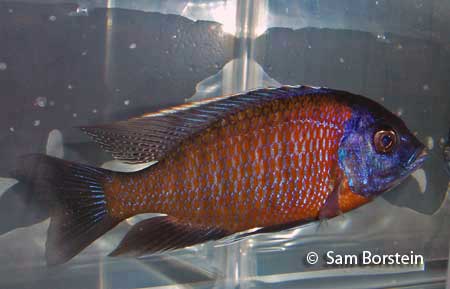Copadichromis borleyi
(Iles, 1960)
Synonyms: Haplochromis borleyi

Above: A male Copadichromis borleyi "Kadango Red Fin". Photo by Sam Borstein.
Etymology:
Genus- Kopas= carved (Greek), chromis= a fish, perhaps a perch (Greek).
Species- borleyi= named after ichthyologist H.J.H Borley.
Intro:
Copadichromis borleyi was first typed in 1960 by Iles. This Malawi Hap is very popular in the hobby and can be found at many pet stores regularly. This fish is found all over Lake Malawi, so therefore has many location variants. The most popular of these variants is the Kadango, or Red Fin Borleyi (pictured above). The nickname of the fish is from the fin color of the females, and the juveniles. When young the color of their fins is orange-red.
The Copadichromis borleyi from Kadango has many color variations within its location variant, as body color on males can look yellow, orange, or even a fire red. The female's fins may also be the above colors.
Distribution:
This fish is found throughout the rocky habitats of Lake Malawi. It is found at many different localities.

Above: A male Yellow fin Copadichromis borleyi. Female in background. Photo by Rick Borstein.
Size, Maturity, and Sexual Dimorphism:
Size: Males- 10 inches, Females- 7 inches
Maturity: 3.5 inches
Sexual Dimorphism: Males are larger than females, and are a lot more colorful than the females which are gray. Males also develop longer pelvic fins.
Care:
Copadichromis borleyi is easy to care for. This fish is relatively calm, and peaceful. The only real aggression I saw was during spawning. This fish does occasionally hold territories, so for a group of 4 at about 4 inches I recommend a 75 community tank. Overall the fish mixes well with similarly mannered Malawi Haps, mbuna, Victorians, and some Tanganyikans.
Diet:
In the wild Copadichromis borleyi feeds on plankton. When feeding this fish in captivity, I recommend a varied diet. I fed mine Tetra Cichlid Sticks, Spectrum, Dianichi Veggie Deluxe, and HBH Graze.
Breeding:
Copadichromis borleyi is easy to breed. The key is getting the females into breeding condition. This fish takes awhile to become gravid, but after that they spawn easily.
The females hold about 25 days. I stripped the female at 20 and the babies were close to free swimming. Feed baby brine shrimp because the fry are small. At about half a week, the red fins start to appear. This fish is easy to raise and rearing the fry poses no problems.
Conclusion:
Copadichromis borleyi is a great fish, and is easy to get. So if you like Malawi Haps, you should try it. It is a classic Malawi Hap and a great addition to a Malawi community tank or a show tank.
References:
- Eccles, D.H. & Trewavas, E. (1989) Malawian cichlid fishes. The classification of some Haplochromine genera. Lake Fish Movies, Herten, Germany, 335 pp.
- Konings, A. (2007) Malawi cichlids in their natural habitat. 4th ed., Cichlid Press, El Paso, Texas, 424 pp.
